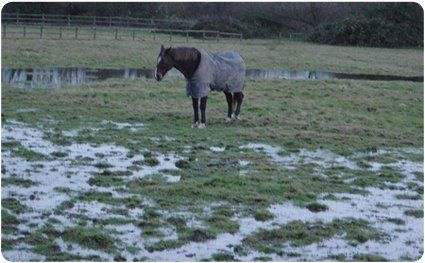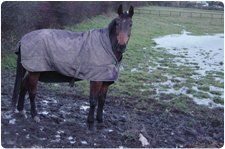Wet Horse Perils
The perils of presenting a wet horse
Article by: David J Nicholls RSS AWCF RJF CNBF CLS
Reposted by: Clive Meers Rainger RSS Bll CNBF CLS
Information on Wet Horses
Having recently lost an entire day of work due to owners putting their horses out in wet, muddy conditions, this heartfelt plea was penned by my good friend David Nichols.

A very wet horse
As we struggle through another wet winter there has been a dramatic increase in equines presented to me wet. I believe this is due to a lack of understanding about our needs as a Farrier and the requirements of the equines we are working on. I have never made a secret of it being completely unacceptable to be presented with a wet horse.
Dry means Dry
The dictionary definition of dry is; "free from moisture" this does not include any other version of dry, i.e. just a little damp - almost dry - nearly dry or I did the best I could.
On wet days, a horse's legs and feet will not dry sufficiently over a whole day thus, horses washed off in the morning will often not be dry enough to shoe for the rest of that day.
I know at times this is inconvenient but The Health and Safety Executive, our Insurers and follows the advice given by our professional association. The Farriers Registration Council, insist that we do not work on wet horses, under any circumstances. You employ me to apply the highest standards of Farriery to your equine friends.
In the past when I have gone through the miserable process of shoeing a wet horse! All I desire is to get the job done as quickly as possible.
This not only puts me into a very poor mental state but compromises my work, also the safety of myself and the equine I am working on. These are shortcuts and risks I will no longer take.
Anyone who does not shoe horses cannot imagine how much effort we use to hold up a proportion of hundreds of kilos and how much of our body we use against the legs and body of the equine we are working on. This process requires friction and when wet, apart from being extremely unpleasant, most of the friction disappears placing your equine friend and myself into an extremely dangerous situation.
Horses' feet have the characteristics of blotting paper and will suck up water from the environment. This causes several problems for us as Farriers.
The feet expand and in some cases this is so extreme we have to increase the size of shoe to accommodate this change. (We often do not have that additional shoe size with us).
Our foot trimming tools are designed to cut hard dry hoof and when the feet are wet, not only does it prematurely blunt them but our rasps clog up and become useless.
Wet feet loose the definition and guidelines we use for assessment and trimming. In this case it is easy for us to make poor decisions about trimming and foot management, which could lead to unnecessary discomfort or lameness.
Hot fitting onto hooves that may appear dry to the eye but are actually saturated can cause super heated steam to be pushed into the feet scolding them.
This can even happen when we shoe on a wet surface. The surface water on the feet cool the foot surface of the shoe and make it impossible to hot seat the shoe safely.
When we nail shoes onto equines feet it requires skill and practice to accurately drive the nails with reasonable safety. As we drive nails into the feet we are reliant not just on the angle we drive the nail into the foot, but also we use the sound and feel as we drive the nails. When feet are not dry, this vital tool is lost and we loose the sound and feel of driving nails. This is obviously an extremely dangerous and unnecessary position to be in for both your equine friend and myself.
Having driven the nails through the hoof and out of the side walls, we cut off the excess nails and pull them tight against the hoof walls. (Forming a "clench") If the walls are wet they are very soft and we are unable to secure the clenches without tearing them down the walls.
Some feet are so soft when wet it is impossible to tighten the clenches fully, leading to the shoes becoming loose. If the feet were not dry at the time of shoeing, when wet feet dry out and shrink down to their optimum size the shoes can become prematurely loose.
Until now I have not fully explained the reasons why dry equines for Farriery are so important and I thank you for taking the time to read this information sheet.
I know most of you do present dry horses and a dry area for me to work on, which means a lot to me and I thank you for both your consideration and the effort involved.

Anyone who does not shoe horses cannot imagine how much effort we use to hold up a proportion of hundreds of kilos and how much of our body we use against the legs and body of the equine we are working on. This process requires friction and when wet, apart from being extremely unpleasant, most of the friction disappears placing your equine friend and myself into an extremely dangerous situation.
Horses' feet have the characteristics of blotting paper and will suck up water from the environment. This causes several problems for us as Farriers.
The feet expand and in some cases this is so extreme we have to increase the size of shoe to accommodate this change. (We often do not have that additional shoe size with us).
Our foot trimming tools are designed to cut hard dry hoof and when the feet are wet, not only does it prematurely blunt them but our rasps clog up and become useless.
Wet feet loose the definition and guidelines we use for assessment and trimming. In this case it is easy for us to make poor decisions about trimming and foot management, which could lead to unnecessary discomfort or lameness.
Hot fitting onto hooves that may appear dry to the eye but are actually saturated can cause super heated steam to be pushed into the feet scolding them.
This can even happen when we shoe on a wet surface. The surface water on the feet cool the foot surface of the shoe and make it impossible to hot seat the shoe safely.
When we nail shoes onto equines feet it requires skill and practice to accurately drive the nails with reasonable safety. As we drive nails into the feet we are reliant not just on the angle we drive the nail into the foot, but also we use the sound and feel as we drive the nails. When feet are not dry, this vital tool is lost and we loose the sound and feel of driving nails. This is obviously an extremely dangerous and unnecessary position to be in for both your equine friend and myself.
Having driven the nails through the hoof and out of the side walls, we cut off the excess nails and pull them tight against the hoof walls. (Forming a "clench") If the walls are wet they are very soft and we are unable to secure the clenches without tearing them down the walls.
Some feet are so soft when wet it is impossible to tighten the clenches fully, leading to the shoes becoming loose. If the feet were not dry at the time of shoeing, when wet feet dry out and shrink down to their optimum size the shoes can become prematurely loose.
Until now I have not fully explained the reasons why dry equines for Farriery are so important and I thank you for taking the time to read this information sheet.
I know most of you do present dry horses and a dry area for me to work on, which means a lot to me and I thank you for both your consideration and the effort involved.

“ I have no doubt that it is wholly though Clive’s skill and patience that Fig is still with us today and is comfortably enjoying his happy retirement… Thank you.”
Julia

“Just a word of thanks, to you Clive, for your consistently outstanding care for the horses.”
Mark
Get in touch with Clive
If you would like to know more about Equine Foot Protection or you have specific question about Natural Balance Farriery or to discuss your particular Farriery needs or just to book an appointment please fill out the for below and we will get back to you
Thank you for contacting us.
We will get back to you as soon as possible
We will get back to you as soon as possible
Oops, there was an error sending your message.
Please try again later
Please try again later
About EFP
With over 45 years of experience Clive has dedicated his career to Farriery and the care of Equine Athletes and Friends alike
Contact info
The Forge, Gabriels Farm, Marsh Green Road, Nr Edenbridge, Kent, TN8 5PP
+44 7884 236892
equinefootprotection@gmail.com

